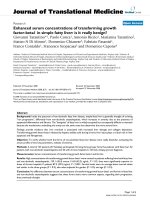Using IVUS to optimize PCI outcome is it really necessary
Bạn đang xem bản rút gọn của tài liệu. Xem và tải ngay bản đầy đủ của tài liệu tại đây (3.64 MB, 40 trang )
Using IVUS to optimize PCI
outcome: is it really necessary?
14th Vietnam National Congress of
Cardiology
Dr Jack Tan
Senior Consultant Interventional Cardiologist
National Heart Centre Singapore
MBBS, MRCP(UK), FAMS(Cardiology), FAsCC
Mechanical Transducer – 40 MHz Atlantis Pro (BosSci)
Solid-State Transducer – 25 MHz EagleEye (Volcano)
Identify specific disease
-
left main stem, ostial lesions
Detect angiographically silent disease
Identify plaque morphology
Examine vessel when angiography is
inconclusive
- transplant vasculopathy
-hazy lesions, presence or absence of thrombus or dissection
Measure plaque load
Measure true vessel size
IVUS Determination of Atheroma Area
Precise Planimetry of EEM and Lumen Borders
with Calculation of Atheroma Cross-sectional Area
Vessel Area
Lumen Diameter
Lumen
Area
Vessel Diameter
Atheroma Area
ANGIOGRAPHY
IVUS
2 dimensional
360º view
Planar
Tomographic and sagittal
Shadow of lumen
Visualisation of shape and
location
Wall structures not imaged
Intermittent snapshots or
repeat contrast injections
necessary
QCA measurements prone to
magnification errors
Visualisation of inner wall
structures and
morphology
Continuous image
Precise measurements
Pre-intervention
During the intervention
Post-intervention
Pre-intervention
estimate hemodynamic significance
precise anatomic analysis (type of
bifurcation, plaque burden in ostial side
branches or left main bifurcation)
reference diameters define normal to normal
segments
Type of lesion preparation required e.g
atherectomy
During Intervention
CTO intervention to guide wires or reentry
Assessment of side branch ostium after
predilatation
Adequacy of debulking post atherectomy
Decision making for LM, bifurcation stenting
Post Intervention
Stent expansion, stent apposition
Diagnosis of complications (dissection,
geographic mismatch, thrombus formation
,plaque protrusion inside the stent
MLA <4 mm2 correlated well with ischemia on SPECT
Nishioka JACC ’99
In a study of 53 intermediate lesions from 43 patients,
correlated moderately well with an FFR <0.75 with
sensitivity 92% and specificity 56%. Brigouri AJC 2001
Low event rates were noted in 300 patients with
intermediate lesions in whom intervention was deferred
for an IVUS MLA >4 mm2 Abizaid Circulation 1999
IVUS-derived MLA > 2.4 mm2 may be useful to exclude
FFR <0.80, but poor specificity limits its value for
physiological assessment of lesions with MLA <2.4 mm2.
FFR or stress tests may be necessary to accurately
identify ischemia-inducible intermediate stenoses.
Kang SJ Circ Card Interv 2011
Patient Referred for ISR of a 2.5 mm stent in the pLAD
4 mm
2.5 mm
Insights
From IVUS
RAO cranial
IVUS
•
IVUS can assist in the differentiation of
restenosis related predominantly to intimal
hyperplasia versus mechanical complications,
such as stent fracture or stent
underexpansion.
•
An IVUS-guided high-pressure angioplasty
with a noncompliant balloon can be the sole
treatment when stent underexpansion is the
major mechanism for restenosis
371 prox lads
LAD size assessment by IVUS
30
Laborgne,
Cheneau et al.
2002
20
10
Insights
From IVUS
0
<3
3.0-3.5 3.5-4.0 4.0-4.5 4.5-5.0 5.0-5.5 5.5-6.0 >6.0
Vessel size: Angiography vs IVUS
IVUS
Moussa et al. AJC 1999;83:1012-1017
IVUS
SIRIUS IVUS sub study. 72 SES and 50 BMS.
Sonoda, et al. JACC 2004;43: 1959-63
MAIN COMPARE REGISTRY
975 elective BMS or DES for unprotected LMCA stenosis
IVUS (756), angiography (219) guidance by operator
discretion
Angiography group was older and sicker
201 propensity-score matching pairs (DES + BMS)
145 propensity-score matching pairs of DES patients
•
•
•
Trend toward lower 3-year mortality with an
IVUS-guided strategy vs angiography alone
(6.0% vs. 13.6%, p =0.063).
Interestingly, in the 145 matched-patient
subgroup receiving DES, the 3-year incidence
of mortality was significantly lower in the
IVUS-guided group (4.7% vs. 16.0%, p 0.048)
Driven by reduced rates of sudden cardiac
death from late stent thrombosis.
Integrated use of FFR and IVUS in left main stenting
Park S et al. J Am Heart Assoc 2012;1:e004556
© 2012 Park S et al.
7484 PCI’s with IVUS: 27 SAT (0.36%)
Inadequate Stent Expansion
Stent malappostition
Dissection
Tissue protrusion
Thrombus post PCI
IVUS Cheneau et al. Circulation. 2003;108:43.
18 (78%)
2 (5%)
4 (17%)
1 (4%)
1 (4%)
Pre-intervention assessment of plaque morphology and
distribution at the side branch ostium.
• Currently, a single-stent strategy with provisional side
branch intervention has become the favored approach for
most bifurcation lesions due to reduced cardiac events.
•
A propensity-matched analysis of patients undergoing PCI
of non–left main bifurcations with DES using
predominantly a single-stent strategy
An IVUS guided PCI strategy (n=487) vs. angio guided
(n=487)was associated with larger post-stent lumen
diameters in both the main vessel and side branch lower
rates of death or MI (3.8% vs. 7.8%, p =0.03)
In 90 bifurcation lesions, a pre-intervention MLA of
>2.4 mm2 in the side branch could accurately predict a
nonischemic post-intervention FFR (> 0.80) in the side
branch (predictive value of 98%) after main branch
stent deployment. However, a MLA<2.4mm2 could
not accurately predict side branch compromise
resulting in an ischemic FFR (predictive value of 40%).
If the pre-intervention side branch MLA is > 2.4 mm2,
provisional side branch PCI can usually be deferred.
If the side branch MLA is <2.4mm2, clinical judgment
and/or side branch FFR should be considered to guide
provisional side branch intervention.
•
•
Subintimal guide wire tracking . IVUS imaging
from the false lumen to guide re-entry of the
wire into the true lumen
In a small series of 31 CTO lesions (of which 22
were previous failed attempts), successful
recanalization was achieved in 100% of cases
using a modified retrograde IVUS-guided
approach.
Rathore S et al.. JACC Intervention 2010









